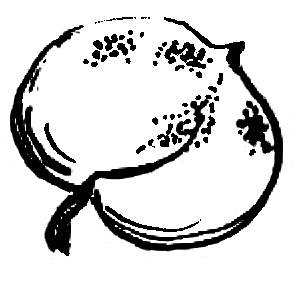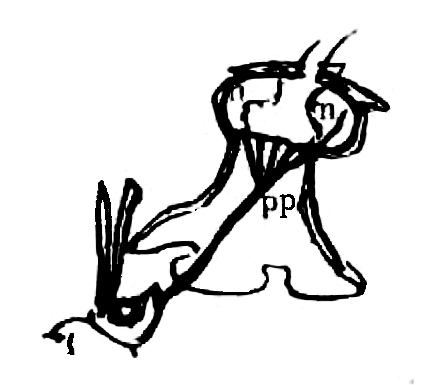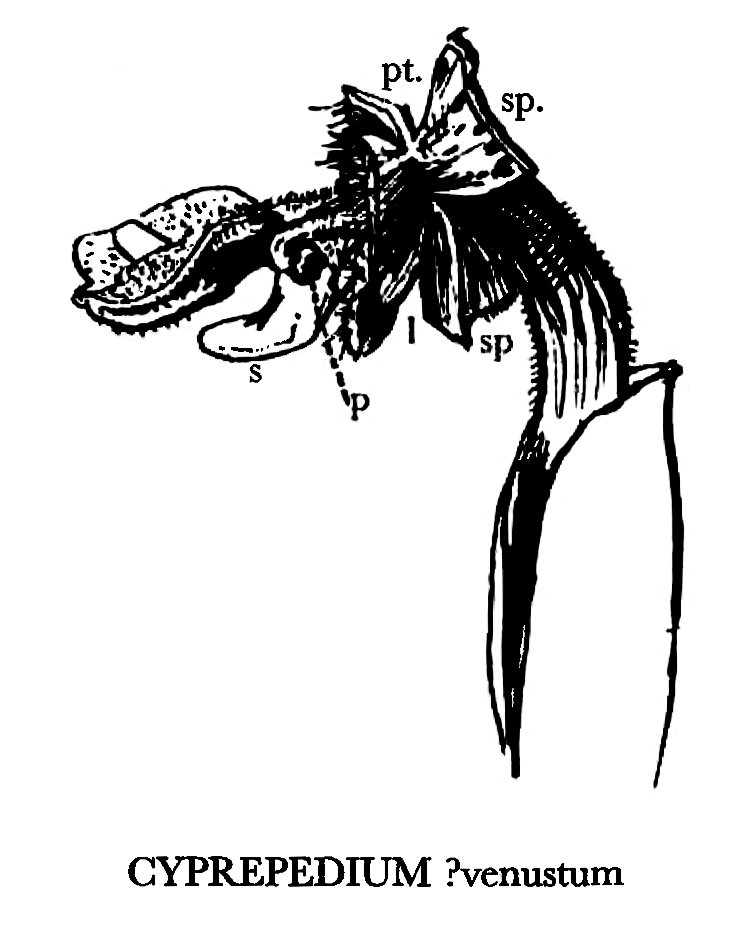From Roland Trimen 16, 17, and 19 July 1863
Colonial Office, | Cape Town. | Cape of Good Hope.
16th. July, 1863.
My dear Sir,
I have to thank you for both your kind letters, respectively of Feb. 16th. and May 23rd., which arrived in due course (the latter to-day).1 I was glad to see the copy of Professor Harvey’s letter to you regarding my drawings, &c, of Orchids.2 He naturally takes a botanist’s view of the matter and looks to the discovery of new species rather than to the special line of research you have so ably opened up. Were all my time my own, I should gladly collect and dry botanical specimens; but as it is, I fear my collections in that way will not be extensive.
What you say about the position of the fertilising organs with reference to the labellum in Satyrium is very striking: the latter do seem on the wrong side.3 When I first showed the common orange Satyrium to Dr. Pappe,4 I spoke of the nectariferous portion of the flower as the “upper sepal” and was quite surprised to hear him pronounce it to be the labellum.
I have tried to induce several persons to collect Orchid roots for transmission to Kew.5 One seems willing to try, but is rather puzzled how to discover the plants in the “veldt” when seeding-time is over. In fact, one ought to be resident on the spot to mark certain plants which might afterwards be dug up. I spoke to the Superintendent of the Botanic Gardens here on the subject, but was unfortunate in so applying, as that gentleman (naturally, it is said, of rather a crusty humour) seemed rather sore on the subject of Kew, asserting that he had on former occasions sent plants to the Royal Gardens, and not met with what he considered proper treatment.6 But if I fail with the roots, you shall certainly have specimens of flowers in spirits.
Many thanks for your portrait: I hope you did not think me presuming too much, on so short an epistolary acquaintance, in asking for it.7 But I have certainly the best of our exchange; mine was a very miserable affair, without character (as a naturalist would say). I shall endeavour to get some taken in the same manner as yours.
I rejoice that I have succeeded in making you break the “sullen vow” that you would publish no more on the Orchid subject.8 You are pleased to be very complimentary on my performances, but I hereby declare that whatever merit they may possess is wholly due to your elaborate book, which opened up a terra incognita to me.9 I think it very kind of you to publish the paper as coming from me, but am hardly satisifed as to the justice of my name being so prominently put forward.10 I feel honoured by any remarks in amplification and explanation which you may have added, and shall be very glad of any copies of the paper which you may have to spare.
Like yourself, I found the subject most fascinating: there is a degree of mystery and wonder in this complete dependence of a whole group of plants upon a tribe of organic beings so remote from them as insects; and one can scarcely resist the idea that the strangely-formed and uniquely-developed Orchids are conscious and active agents in this constant mutually-advantageous intercourse. When I now look at a growing Orchid, I cannot help regarding it as a more intellectual being than other plants.
I intend to do my best to make further investigations as soon as I have got the second part of my Catalogue of the S. African Butterflies off my hands.11 I have been a good deal encouraged of late in observing the growing interest in entomology in this part of the world, and am happy to think that I have not been unsuccessful in aiding the diffusion of a taste for collecting. My best correspondent is a gentleman in the Frontier Mounted Police, who is stationed in a thickly-wooded region of Kaffraria Proper.12 He has sent down quite an extensive collection of Lepidoptera, and, being a good observer, numerous interesting notes on habits & localities.
In connection with the subject of Moths being able to perforate membranes with their proboscis,13 I think it as well to mention the following. Since the last winter, which was excessively wet, certain Moths have been extraordinarily abundant, their larvæ causing serious ravages among the crops. The pest in this neighbourhood and over most of the Western Districts was Heliothis armigera, in the spring; the larvæ appearing in legions in the early summer (October to January). But in the middle of January, at Grahamstown, in the Eastern Province, a quite different moth was reported in the papers as doing much damage to fruit. I have since learnt from Mrs. Barber (who is, I believe, a botanist, and a good correspondent of Harvey’s) that this is a fact; and from specimens this lady forwarded, have ascertained the Moth to be Achæa Chamæleon Guén, a good-sized Quadrifid Noctua, excessively variable in colour & marking.14 I wrote to inquire as to particulars, asking whether the Moths ever sucked sound peaches, or if they did not rather confine themselves to those already injured by birds, remarking that I thought it impossible for the moths’ trunk to pierce the tough skin. To this I received the following answer from Mrs. Barber:—“The moths certainly do puncture the skin of the peaches, commencing near the apex, where the peach first ripens, and puncturing it in patches, thus:—
 and the small holes made by their proboscis can be distinctly seen. Much of the fruit destroyed by them was very green, for they came in such multitudes that “the famine was sore in the land” with them, and they were obliged to take what they could find.” Mrs. B. had previously informed me that “in the evening you might see more than a dozen of them settled on one peach, draining the juices from it till there was nothing left but the stone and the epidermis of the fruit.”. Does not this seem rather a strong case in favour of your belief (Fertil. of Orch. p. 50) that Moths perforate the lax inner membranes of the nectaries of Orchis to suck the fluid enclosed between it and the outer membrane? If Moths really possess such perforating power, in greater or less degree according to their size, one can still well believe that the nocturnal work of Orchid fertilisation, at any rate, is chiefly theirs,—as the chief difficulty with regard to their actually being the fertilising agents of the species with empty nectaries was their presumed want of this power.15
and the small holes made by their proboscis can be distinctly seen. Much of the fruit destroyed by them was very green, for they came in such multitudes that “the famine was sore in the land” with them, and they were obliged to take what they could find.” Mrs. B. had previously informed me that “in the evening you might see more than a dozen of them settled on one peach, draining the juices from it till there was nothing left but the stone and the epidermis of the fruit.”. Does not this seem rather a strong case in favour of your belief (Fertil. of Orch. p. 50) that Moths perforate the lax inner membranes of the nectaries of Orchis to suck the fluid enclosed between it and the outer membrane? If Moths really possess such perforating power, in greater or less degree according to their size, one can still well believe that the nocturnal work of Orchid fertilisation, at any rate, is chiefly theirs,—as the chief difficulty with regard to their actually being the fertilising agents of the species with empty nectaries was their presumed want of this power.15
Mr. Bates very kindly sent me his interesting paper on the Amazonian Heliconidæ, which I like exceedingly.16 I wrote to him by last mail in relation to certain points he advanced. It is interesting to observe how, one after another, naturalists eminent for thought or observatory power are forced into admitting the mutability of species.
With kind regards, believe me, dear Sir, | Yours very truly, | Roland Trimen.
P.S. (17th. July) With regard to Oxalis, I went to-day to the seed-house at the Gardens to ask if any seeds of the genus were to be had, but was unsuccessful, none being kept in stock.17 I will endeavour to collect a few myself. A very common, large and handsome, bright-yellow species (O. cernua?), grows everywhere in and about the town. I gathered at random 10 flowers of this kind, and found that 3 of that number had the elongated pistils. It was quite pleasant to find my first handful so good a case in point. I have made a very rough, hurried sketch of the appearance of the column in both cases, which I enclose; together with two flowers of the species, respectively presenting the variations you note.18 This species of Oxalis is very much frequented by some small Staphylinus-like insects, which are always moving about, and must be excellent conveyers of pollen in a flower whose petals so closely surround the reproductive organs. On one of the flowers gathered today, there was a strange-looking little blackish-grey Aphis, with a hump-back.
If you can find time, tell me what interesting discovery you have made with regard to this exchange of position between the stigmas and 5 higher anthers.19
I had a fine Cypripedium flower to examine the other day, and fully verified your lucid explanation of the method of fertilisation induced by its unique structure.20 My specimen differed a good deal in detail from the species figured in your book, as you will see from the enclosed rough outline (lateral view) of column What is the use of the conspicuous ridged knob on the face of the “rudimentary shield-like anther?” I had no time to make a careful drawing.
19th.— Are you aware how very complete an insect-trap is an Asclepiadaceous plant, named “Physianthus albens” (in the Gardens here)? Last January, a gentleman told me that there was a plant “which caught butterflies” in the gardens, and I accordingly went to investigate. The plant is a creeper, purporting to come from Buenos Ayres. The cluster presented a singular spectacle, as from 30 to 40 specimens of Moths & Butterflies, besides other insects, were anchored fast, by the proboscis, to the dingy-white flowers, many of them fluttering vainly to escape. I at first imagined that it was some extremely viscid substance that kept them prisoners, but, on examination, attributed it rather to a mechanical force. The flower has a 5-partite corolla, which is tubular, the nectaries forming 5 swellings at the base. I omitted to make drawings at the time, but this fancy diagram
 will give you an idea of the process. Around the column (ovary?) are 5 pairs of plates, pp so arranged that the very narrow interstice between each two plates exactly commands, and is the only way of access to, each of the 5 nectary compartments,—the throat of the flower being so constricted that the column fills it. It appears to me that as soon as a proboscis is pushed into the slit between a pair of plates, the latter close on it after the fashion of a vice. In only two instances did I succeed in pulling flower and insect apart without fracturing the proboscis, so firm is the hold of the plates. If you think the case is new or (or needs elucidation) I will endeavour, next summer, to draw up a paper on the subject, with proper illustrations, which I will send you.21 The flowers are very strongly honey-scented. Noctuæ are the principal victims, but even powerful Sphingina (Chærocampa) are quite unable to escape when once trapped. I fear you will hardly thank me for so lengthy an epistle—but it is so pleasant, in a place where a naturalist is almost universally ridiculed or thought a trifler, to communicate one’s ideas and observations to a mind so full of sympathy as your own. I sincerely trust that your health, which I am sorry to hear is delicate, is now more confirmed, and that the laborious works on which you are engaged are progressing satisfactorily.
will give you an idea of the process. Around the column (ovary?) are 5 pairs of plates, pp so arranged that the very narrow interstice between each two plates exactly commands, and is the only way of access to, each of the 5 nectary compartments,—the throat of the flower being so constricted that the column fills it. It appears to me that as soon as a proboscis is pushed into the slit between a pair of plates, the latter close on it after the fashion of a vice. In only two instances did I succeed in pulling flower and insect apart without fracturing the proboscis, so firm is the hold of the plates. If you think the case is new or (or needs elucidation) I will endeavour, next summer, to draw up a paper on the subject, with proper illustrations, which I will send you.21 The flowers are very strongly honey-scented. Noctuæ are the principal victims, but even powerful Sphingina (Chærocampa) are quite unable to escape when once trapped. I fear you will hardly thank me for so lengthy an epistle—but it is so pleasant, in a place where a naturalist is almost universally ridiculed or thought a trifler, to communicate one’s ideas and observations to a mind so full of sympathy as your own. I sincerely trust that your health, which I am sorry to hear is delicate, is now more confirmed, and that the laborious works on which you are engaged are progressing satisfactorily.
I see some laughable “skits” upon your theory in the “Illustrated Times”, consisting of a series of absurd (but clever) sketches illustrating the development of a man servant making off with a dish of eatables from a dog stealing some bones, and other equally sage instances.22 I was glad to see some remarks of yours in the April “Athenæum” showing how different your theory essentially is from that of Lamarck.23
R. T.
Layard24 tells me that he has seen a moth sucking at a sound peach, and believes that it pierced the skin. I have seen one statement (if not two) in the “Ent. Weekly Intelligencer”, of Moths having refused to answer the invitation to “sugar” in consequence of their attachment to blackberries.25
[Enclosure 1]

[Enclosure 2]
[Packet containing flowers.]
CD annotations
Footnotes
Bibliography
Bates, Henry Walter. 1861. Contributions to an insect fauna of the Amazon valley. Lepidoptera: Heliconidæ. [Read 21 November 1861.] Transactions of the Linnean Society of London 23 (1860–2): 495–566.
Collected papers: The collected papers of Charles Darwin. Edited by Paul H. Barrett. 2 vols. Chicago and London: University of Chicago Press. 1977.
Desmond, Ray. 1994. Dictionary of British and Irish botanists and horticulturists including plant collectors, flower painters and garden designers. New edition, revised with the assistance of Christine Ellwood. London: Taylor & Francis and the Natural History Museum. Bristol, Pa.: Taylor & Francis.
‘Fertilization of orchids’: Notes on the fertilization of orchids. By Charles Darwin. Annals and Magazine of Natural History 4th ser. 4 (1869): 141–59. [Collected papers 2: 138–56.]
Orchids: On the various contrivances by which British and foreign orchids are fertilised by insects, and on the good effects of intercrossing. By Charles Darwin. London: John Murray. 1862.
Trimen, Roland. 1862–6. Rhopalocera Africæ Australis; a catalogue of South African butterflies, comprising descriptions of all the known species with notices of their larvæ, pupæ, localities, habits, seasons of appearance, and geographical distribution. London: Trübner. Cape Town, South Africa: W. F. Mathew.
Trimen, Roland. 1863. On the fertilization of Disa grandiflora, Linn.... drawn up from notes and drawings sent to C. Darwin, Esq., FLS, &c. [Read 4 June 1863.] Journal of the Proceedings of the Linnean Society (Botany) 7 (1864): 144–7.
Trimen, Roland. 1887–9. South-African butterflies: a monograph of the extra-tropical species. With the assistance of James Henry Bowker. 3 vols. London: Trübner.
Summary
Thanks CD for two letters and his portrait.
CD’s book [Orchids] opened up terra incognita for him.
His work on S. African butterflies continues.
Reports on a moth that punctures peach skins.
Interesting that thoughtful naturalists are forced to admit mutability of species.
Some notes on Oxalis.
Letter details
- Letter no.
- DCP-LETT-4243
- From
- Roland Trimen
- To
- Charles Robert Darwin
- Sent from
- Cape Town
- Source of text
- DAR 99: 13–16d, DAR 142: 37
- Physical description
- ALS 12pp † encl drawing and packet of flowers
Please cite as
Darwin Correspondence Project, “Letter no. 4243,” accessed on 19 April 2024, https://www.darwinproject.ac.uk/letter/?docId=letters/DCP-LETT-4243.xml
Also published in The Correspondence of Charles Darwin, vol. 11


